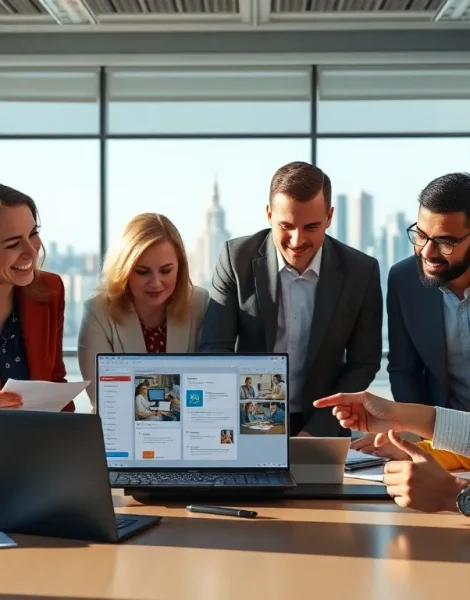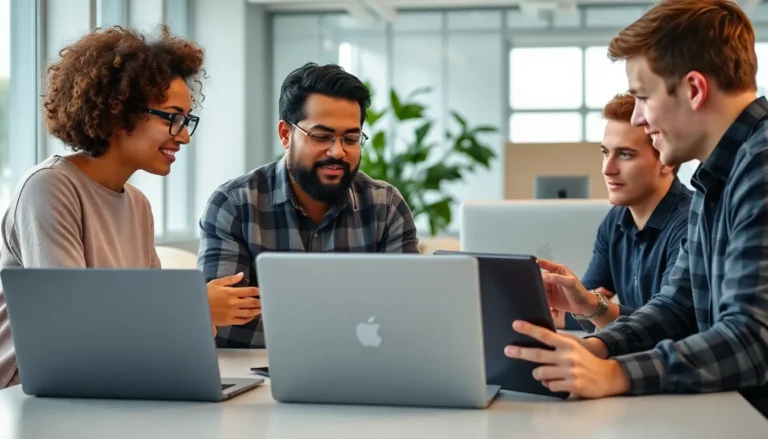In a world where NGOs and governments often seem like oil and water, collaboration tools are the secret sauce to mix them up into a delicious recipe for success. Picture this: a bustling NGO working tirelessly to improve community welfare, while the government is trying to keep up with red tape and bureaucracy. What if they could join forces seamlessly? With the right collaboration tools, they can turn chaos into harmony and make the world a better place—one project at a time.
These tools not only streamline communication but also foster transparency and accountability. Imagine a virtual roundtable where ideas flow freely, decisions get made faster than a coffee break, and everyone’s on the same page. By leveraging these innovative solutions, NGOs and governments can tackle challenges head-on while keeping the humor alive—even when things get a bit bureaucratic! Let’s dive into the world of NGO-government collaboration tools and discover how they can transform partnerships for the greater good.
Table of Contents
ToggleOverview of NGO-Government Collaboration Tools
Collaboration tools play a crucial role in fostering effective partnerships between NGOs and governments. These tools enhance communication, ensuring that both entities share information seamlessly. Platforms like project management software facilitate joint planning and execution of initiatives.
Transparency remains critical in any collaborative effort. Online reporting systems allow NGOs and governments to track progress and share updates with stakeholders. Through these systems, both parties can demonstrate accountability to the communities they serve.
Data-sharing applications enable real-time access to vital information. By leveraging cloud-based solutions, NGOs and governments can analyze data sets collectively, uncovering insights that drive better decision-making.
Mobile applications provide an additional layer of accessibility, allowing field workers to report findings directly from their locations. This immediacy helps to address issues promptly, enhancing overall project responsiveness.
Webinars and online training sessions offer learning opportunities for both sectors. Skill-sharing platforms promote knowledge exchange, ensuring that best practices are disseminated effectively.
Social media tools facilitate outreach and community engagement. Both NGOs and governments can use these channels to inform the public, solicit feedback, and promote their shared initiatives.
Integrating these collaboration tools can lead to more impactful partnerships. By utilizing technology, NGOs and governments effectively address community needs and improve service delivery.
Types of Collaboration Tools

NGOs and governments utilize various collaboration tools to enhance their partnership effectiveness. These tools streamline processes and foster better communication between entities.
Communication Platforms
Communication platforms play a crucial role in NGO-government collaboration. Tools like Slack or Microsoft Teams facilitate real-time conversations, enabling quick decision-making. Email services enhance formal communication, keeping records of discussions. Video conferencing tools such as Zoom or Google Meet allow for face-to-face interactions, crucial for building relationships. These platforms create spaces for brainstorming, feedback, and updates, ultimately enhancing alignments between teams.
Project Management Software
Project management software offers structured solutions for planning and executing joint initiatives. Tools like Asana or Trello help manage tasks, set deadlines, and assign responsibilities clearly. Visual dashboards make it easy for teams to track progress collectively. Collaboration on deliverables occurs in real time, reducing misunderstandings and delays. By maintaining organized workflows, these tools ensure both NGOs and governments stay focused on common objectives.
Grant Management Systems
Grant management systems streamline the application and funding processes. Platforms such as Fluxx or FoundationConnect enable NGOs to submit proposals efficiently and track application statuses. These systems often provide transparency, allowing governments to monitor disbursements and impact. Reporting functionalities ensure that all parties adhere to budgets and deadlines, promoting accountability. Seamless integration with financial tools strengthens collaboration between NGOs and funding agencies.
Benefits of Using Collaboration Tools
Collaboration tools offer extensive advantages for NGOs and government partnerships. They streamline processes, elevate communication, and strengthen community impacts.
Enhanced Efficiency
Enhanced efficiency occurs through the use of project management software. This software simplifies task assignments, deadlines, and progress tracking. Teams can coordinate activities more seamlessly, reducing time lost in bureaucratic delays. Automating repetitive tasks allows for increased focus on high-impact initiatives. Additionally, real-time updates keep all stakeholders informed, ensuring everyone stays aligned on objectives. Ultimately, these tools facilitate a smoother workflow, enabling projects to progress at a faster pace.
Improved Transparency
Improved transparency becomes evident with online reporting systems. These systems provide clear visibility into project activities and funding utilization. By sharing updates and performance metrics frequently, both NGOs and government entities foster trust within communities. Increased accountability arises as stakeholders access shared information, prompting higher engagement from all parties involved. Transparent practices help identify challenges early, allowing for prompt action to address issues. Overall, these tools promote an open environment that enhances stakeholder confidence and participation.
Strengthened Relationships
Strengthened relationships flourish through effective communication platforms. Regular interactions using tools like Slack or Microsoft Teams enhance collaboration between NGOs and governments. Open communication channels allow concerns to be addressed quickly, minimizing misunderstandings and fostering teamwork. Video conferencing tools provide face-to-face engagement, crucial for building rapport and mutual respect. Through webinars and online training, skill-sharing opportunities arise, benefiting both organizations. This collaborative environment cultivates lasting partnerships that align on shared goals, ultimately benefiting communities more effectively.
Challenges in Implementation
Implementing collaboration tools between NGOs and governments presents several challenges that hinder effective partnerships.
Technological Barriers
Technological limitations often obstruct effective collaboration. Many NGOs operate on constrained budgets, restricting access to advanced tools. Insufficient training on new technology leads to decreased utilization. Compatibility issues may arise when integrating different systems between NGOs and government departments. Organizations may struggle to keep up with technology updates, which can lead to outdated practices. Additionally, reliance on inconsistent internet connectivity can disrupt real-time communication. Without resolving these technological barriers, achieving seamless collaboration becomes difficult.
Resistance to Change
Resistance to change plays a significant role in delaying the adoption of collaboration tools. Employees in both NGOs and government entities may feel apprehensive about altering established workflows. Anxiety about new systems can lead to reluctance in adopting innovation. Engaging stakeholders early in the process may help alleviate concerns and foster buy-in. Clear communication about the benefits of collaboration tools can also encourage acceptance. Additionally, successful implementation often requires time and patience to shift mindsets. Fostering a culture that embraces change ultimately enhances collaborative efforts.
Case Studies of Successful Collaborations
Success stories illustrate the power of NGO-government partnerships and showcase effective collaboration tools in action.
Example 1: Project Implementation
A notable collaboration occurred in rural health initiatives. A government health department partnered with a local NGO to deliver essential services. Project management software enabled them to coordinate efforts in planning and execution efficiently. Task assignments and progress tracking helped create clear workflows. Real-time data-sharing applications granted access to vital information, allowing both entities to analyze community health needs promptly. Their use of online reporting systems ensured transparency, building trust among stakeholders. As a result, this synergy increased service delivery, improving health outcomes for thousands.
Example 2: Funding Initiatives
Another exemplary collaboration centered on educational programs. A national education ministry worked with an NGO to launch a scholarship initiative. The grant management system streamlined the application and funding processes, promoting accountability. Access to user-friendly platforms, such as online application forms, fostered ease of participation for institutions and students. Regular updates through communication platforms kept all parties informed about funding utilization. Both organizations leveraged social media for outreach, engaging communities effectively. This collaboration not only supported students directly but also strengthened ties between government and non-profit sectors.
NGO-government collaboration tools are essential for fostering effective partnerships that address community needs. By leveraging these tools, both sectors can enhance communication and streamline processes, ultimately leading to improved service delivery. Overcoming implementation challenges is crucial for maximizing the benefits of these innovative solutions.
Success stories from various initiatives showcase the tangible impact of collaboration on community welfare. As NGOs and governments continue to collaborate, the integration of these tools will pave the way for a more efficient and transparent approach to tackling societal issues. Embracing this synergy not only strengthens relationships but also empowers communities to thrive.








